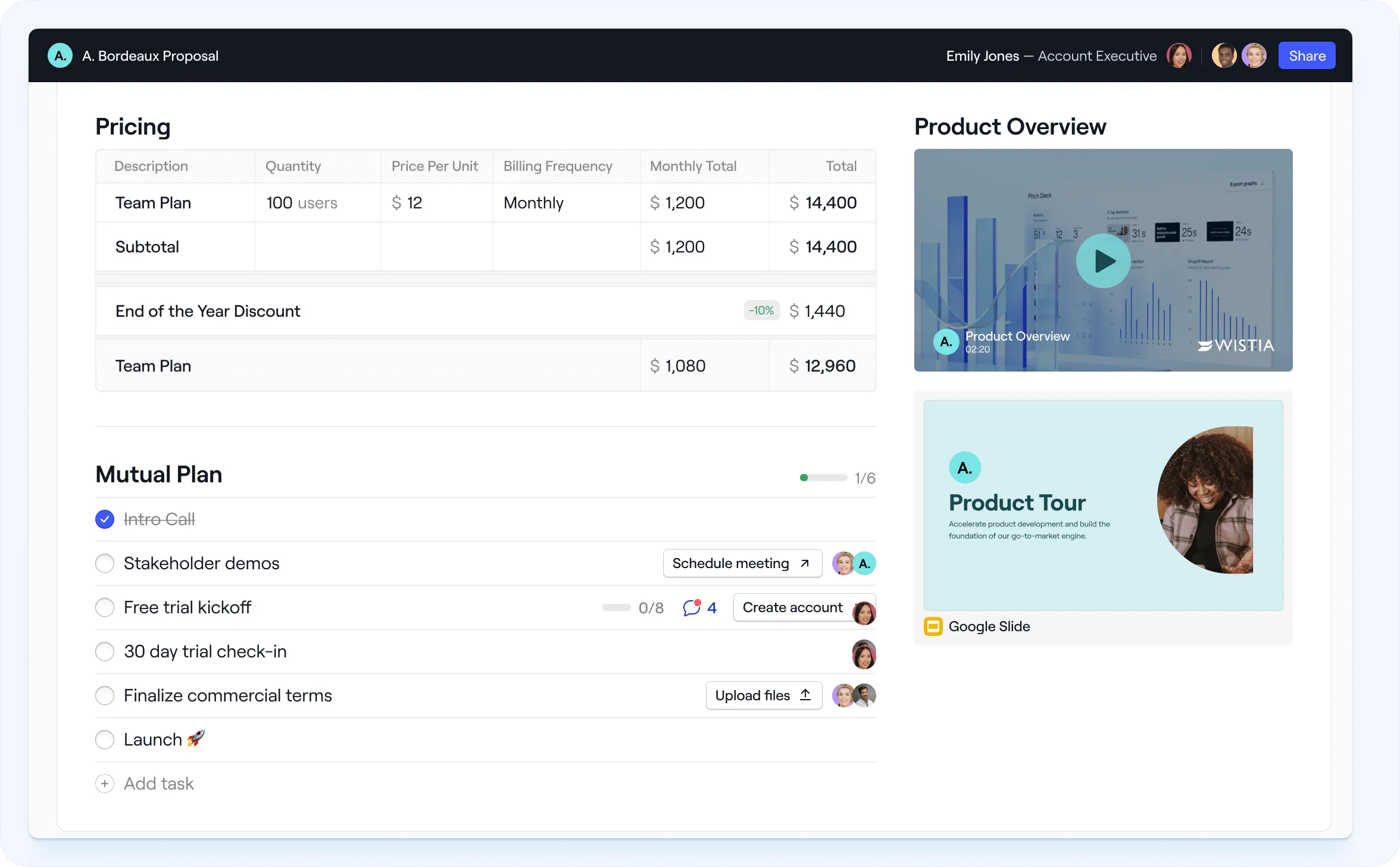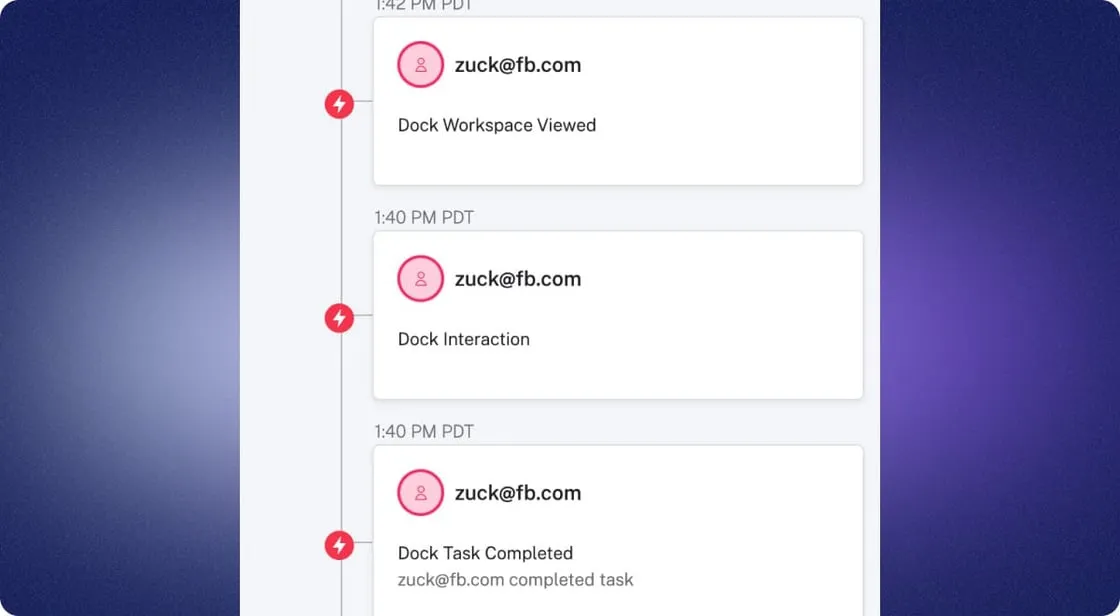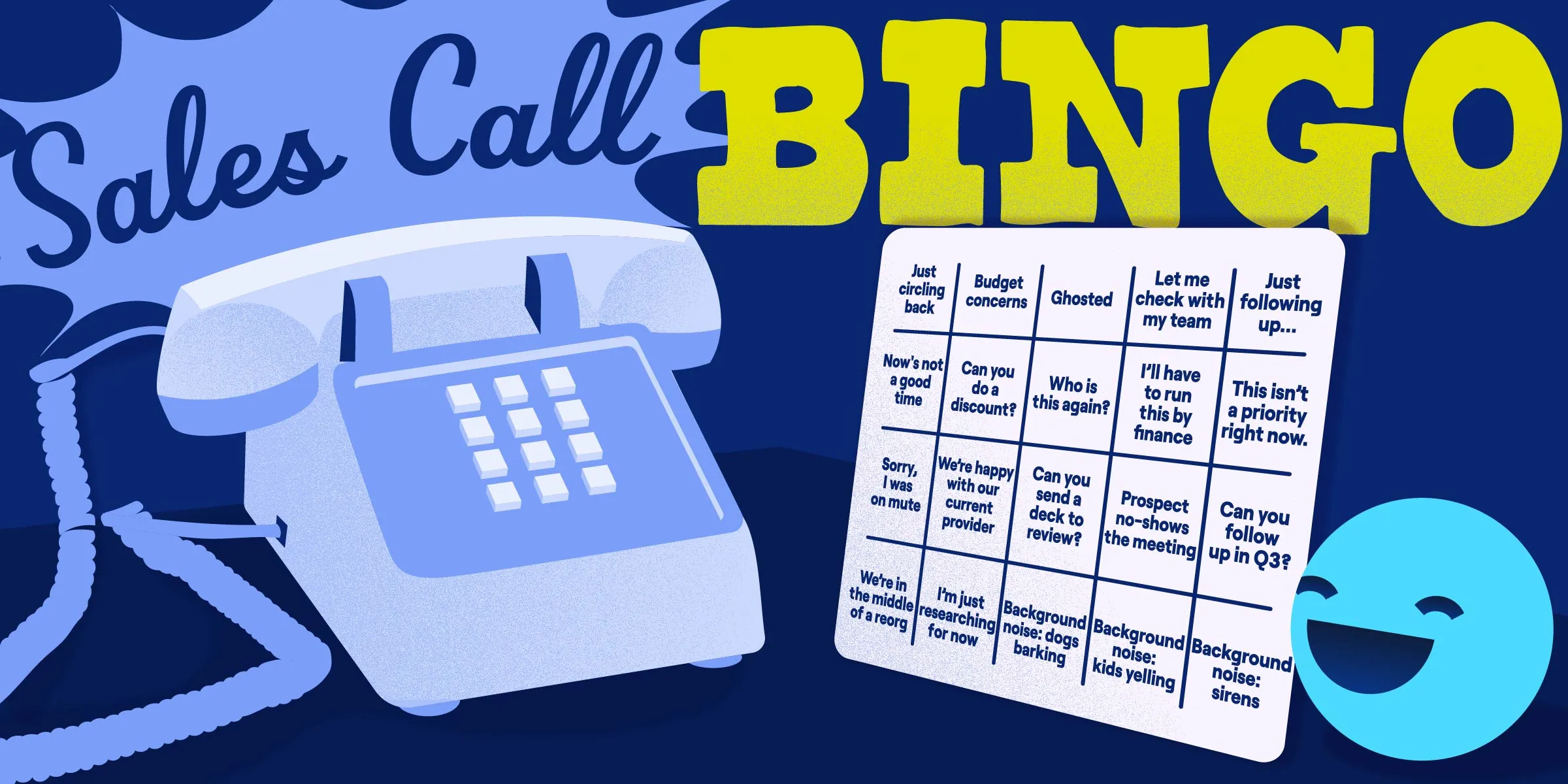Product
TABLE OF CONTENTs
TABLE OF CONTENT
Just like flip phone, the days when one sales rep could handle large-scale B2B deals from pitch to close are gone. The more complex the deal, the more people you need.
Enter team selling—a sales strategy that embraces a tag-team, hand-to-hand combat style to closing deals.
But why does team selling work? And how can your team maximize its potential to meet (and exceed) your targets?
In this post, you'll learn:
- The mechanics of team selling
- The roles each team member plays
- Actionable tips to make team selling your competitive advantage
- What tools and tech can make it all come together
What is team selling?
Team selling involves using multiple client-facing roles to work a sales deal rather than the traditional model of using one salesperson per account.
Team selling can involve multiple sellers (e.g., an AE, a BDR, and a sales leader) and/or multiple departments (e.g., Sales Engineering, Customer Success, Product Marketing, and Professional Services).
The team selling approach is most valuable in complex deals with large buying teams and longer sales cycles (think: enterprise deals) where a variety of skill sets and expertise are needed across the sales cycle.
The most extreme version of team selling is “selling pods”—dedicated three-person teams of one AE, BDR, and CSM work deals from start to finish. These pods ensure all aspects of the sale are covered, from initial contact to closing the deal.
In the most general sense, taking a team-selling approach means working as a cohesive revenue unit to close account-based sales.
Why team selling is so hot right now
The complexity of the buying and selling process has largely driven the rise of team selling.
According to Gartner research, B2B purchasing decisions are typically made by buying committees of 6-10 people, not individuals.
The buying teams themselves are complex, but so are the buying jobs they need to complete to make a purchase. Gathering internal requirements, comparing vendors, completing security reviews, and appeasing financial stakeholders all takes a village.
To match these buying teams pound-for-pound—both in terms of size and technical jobs to be done—sales teams have to respond with a team selling approach.

Here's why team selling works:
- Improved coverage: More sellers mean more touchpoints. This helps keep the deal moving forward with continuous engagement and responsiveness to questions or roadblocks.
- Diverse expertise: Different team members bring unique skills and knowledge to the table, covering all aspects of the buyer's needs.
- More trust: Interactions with a variety of team members across roles and functions can build greater trust and credibility with the buyer solidifying the customer relationship from the start.
Who's involved in team selling?
Team selling has a variety of roles from both in and outside the sales team. Here's a breakdown:
On the Sales team
- Sales leadership: High-level sales leaders like the VP of Sales can show the buyer they’re getting white-glove attention and commitment
- Account executives: Account managers typically handle the sales process, leading relationships, and negotiations
- Business development representatives: Usually sales reps that are the first point of contact—responsible for prospecting and qualifying leads
- Sales engineers: Provide technical expertise and address complex product questions, concerns, and potential tech roadblocks
- Deal desk: Support for complex quoting, order forms, contracts, and more.
From other revenue teams
- Founders: Especially in startups, founders and CEOs can add a personal, white-glove touch and demonstrate commitment
- Sales Enablement: Provides tools, content, and training to support the sales team.
- Customer Success: Engaging these teams early can give buyers confidence in post-sale support and smooth onboarding
- Marketing: Runs targeted campaigns and supports account-based marketing (ABM) efforts
- IT: Offers insights into product capabilities and integration with the buyer's existing systems
- Investors: Can leverage their network to create connections and build credibility
Team selling tips
As with any team game, you need a game plan. Here are some strategies, tools, and tips to get team selling right.
1. Foster cross-team collaboration
Before you can focus on your buyers, your internal teams need to be working in sync.
Cross-team collaboration is essential for team selling. It ensures all company functions are aligned and unified. This means having Sales, Marketing, and Customer Success teams operate as one unit instead of in silos.
- Integrate campaign efforts: Coordinate between Sales and Marketing to create unified account-based marketing (ABM) campaigns. Eliminate silos by ensuring everyone is aware of ongoing marketing efforts and how they align with sales goals.
- Create a shared content repository: Develop product marketing collateral that every team knows how to find. Think: case studies, whitepapers, and product demos in a sales CMS like Dock that makes it easy to share content with prospects and clients.
- Hold regular cross-team meetings: Want your teams out of silos? Schedule regular meetings to discuss projects, insights, and strategies to help identify potential gaps or overlap in efforts.
2. Focus on multithreading and account mapping
Multithreading connects team members from your org with stakeholders on the buyer’s side. This way, if one relationship falters or you’re not building a connection with the right person from the get-go, others can keep the deal on track.
To implement multithreading with account mapping, you need to:
- Identify and map out your buyer’s org: Identify the key players involved in the buying decision. Then, use this information to create an account map (a detailed map that includes all relevant stakeholders, their roles, and their influence within the organization).
- Assign team members to stakeholders: Once the account map is finished (keeping in mind it’s dynamic and should be revisited for changes) assign your team members to specific stakeholders based on their expertise and the stakeholder’s needs. (For example, pair your tech expert with the buyer’s IT department.) Then, have your team start building relationships with those specific people.
- Engage across multiple channels: Building relationships requires consistent (and varied) engagement. Meet folks where they are, not where you want them to be. Use a mix of communication channels (email, phone calls, LinkedIn, face-to-face meetings, etc.) to connect.
On our show Grow & Tell, Jen Igartua, RevOps expert and CEO of Go Nimbly, discussed the importance of social selling in breaking through all the digital noise created by automated sales outreach and follow-up.
“A lot of sales teams are going into Salesforce, getting a lead, and saying ‘add to outreach’, hitting the campaign, pressing save and calling it. And so I think the pendulum needs to swing back…”
“I think we're going back to the '80s doing business on golf courses. Events are up. I'm flyin˜ıg around and going events. I wasn't doing that two years ago. People are craving that human connection, and they want to buy in person and through humans again. I think that's going to influence the role of SDRs and AEs.” - Jen Igartua, CEO of Go Nimbly
- Leverage your tech: Tools like Dock’s digital sales rooms will help you coordinate these efforts in one place and track engagement. Sales rooms centralize all sales materials and interactions, making it easier for your team and your customer’s team to stay organized and informed.
Here’s how it works:
- Build a sales template for your organization and populate it with relevant materials like sales decks, case studies, and mutual action plans
- Copy the template to create a unique sales room for each customer
- Lightly personalize it based on your conversations (e.g. embed meeting recordings or add relevant case studies)
- Use Dock’s engagement tracking to monitor which stakeholders interact with your content

3. Use Mutual Action Plans
Mutual action plans are shared to-do lists outlining the steps and responsibilities required for joint sales success. They ensure every team member on the buying and selling side knows their role and responsibilities.
Mutual action plans include:
- Actionable next steps
- Key milestones
- Responsible parties
- Timelines
- Success criteria
The goal is to keep both the buying and selling teams aligned—reducing unexpected roadblocks and creating a smoother sale—and anchored to a timeline.
Here's how to use one:
- Make it from the buyer’s perspective: MAPs should be buyer-centric, focusing on buyer goals, timelines, and success. For example, don’t make the last step “Sign contract”—make it “Start implementation.”
- Tailor to the sale: Your MAP's complexity should match your sales process's complexity. For more straightforward sales, keep the MAP concise. For more complex or enterprise deals, it should be more comprehensive and detailed.
- Don’t use a spreadsheet: Sales teams often resort to messy spreadsheets to manage mutual action plans. Dock makes mutual action plans far more user-friendly.
- Transition to onboarding: Don't end your mutual action plan at the close. Use it to transition smoothly into the customer onboarding process for continuity and a seamless handover.
Pro tip: Use Dock's mutual action plan template, where both teams can collaborate, comment, and track real-time progress in a sales room (with plenty of surrounding context).
4. Enable your buyers
Buyer enablement is about making the process as smooth and straightforward as possible. It's about providing the right information and tools at each stage of the buyer's journey.
In team selling, enablement ensures every member can contribute by providing a clear roadmap and relevant resources—helping avoid miscommunication and redundancy. Enablement builds stronger relationships through transparency, trust, and more personalized and informed interactions.
Here's how it can look at different stages:
- Problem identification: Share thought leadership content, industry benchmarks, and diagnostic tools to help buyers clearly define their problems.
- Solution exploration: Offer clear, value-focused content (pricing with context, trend reports, short video demos, etc.).
- Requirements building: Provide buying guides, checklists, and demos to help buyers outline their needs and feel confident in their decision-making process.
💡 Tip: Dock workspaces facilitate a seamless buying experience by centralizing all relevant information. Use Dock's digital sales room (DSR) to organize content, collaborate, and keep stakeholders aligned.
How to track team selling success
Tracking the success of your team-selling efforts is crucial for improvement and success.
So, what are some key metrics, and how can you track them?
1. Number of seller-side contacts involved in a deal
- Why it matters: Helps you understand how many of your team members actively engage with the buyer
- How to track it: Use tools like Dock to monitor and analyze the engagement levels of each seller involved in a deal. Dock’s analytics provide detailed insights into who is interacting with the buyer and how often.
2. Number of buyer-side contacts in a deal
- Why it matters: More sellers typically lead to more buyer engagement, increasing the chances of closing the deal
- How to track it: Dock can track the number of buyer-side contacts interacting with your content. This helps you see if you’re effectively engaging multiple stakeholders within the buyer’s organization
3. Buyer engagement levels
- Why it matters: High engagement levels with your sales room indicate strong interest and involvement from both sides, which is crucial to closing more deals
- How to track it: Monitor individual activity, like frequency and depth of interactions with shared content
4. Deal velocity
- Why it matters: Faster deal progression can correlate with higher sales win rates
- How to track it: Measure the time taken to move deals through different stages of the pipeline and identify any bottlenecks
5. Win rate
- Why it matters: Indicates the effectiveness of your team selling strategy
- How to track it: Track the percentage of team-selling deals that successfully close compared to those that don’t
Team selling tools
The right tech stack can help you implement a successful team selling strategy. These tools not only streamline your processes but also boost collaboration across teams so everyone is on the same page.
Here’s a breakdown of the types you should consider:
1. CRM integrations for communication & collaboration
Every sales team lives in their CRM. But if your CRM lacks the collaborative features necessary for syncing with other teams like Customer Success and Marketing, you’ll need a solution for cross-team collaboration.
What to consider
- Seamless data sharing: Choose a CRM that enables seamless data sharing and collaboration across all departments so everyone is on the same page and can access necessary information.
- Integration capabilities: Your CRM and email tools should integrate smoothly with other platforms to create a cohesive workflow.
- A good UX: Opt for tools with an intuitive interface that encourages adoption and consistent use.
Tools
CRM-wise, HubSpot and Salesforce offer the most third-party integrations and are the most popular choices for sales teams.
In terms of CRM integrations, Fathom is great for summarizing meetings, Scratchpad is useful for CRM hygiene, and Dock’s CRM integrations are great for cross-team collaboration in workspaces.

2. Digital sales rooms
Dock's digital sales rooms centralize all sales materials and interactions, giving your teams a streamlined and organized approach to managing sales.
Key features
- Engagement tracking: Keep track of buyer and seller engagement, showing how often each seller has taken action within a workspace.
- Content centralization: Store all necessary materials, including presentations, case studies, and mutual action plans, in one accessible location.
- Real-time collaboration: Use shared workspaces for seamless collaboration where teams can comment, update, and track progress.
Tools
Dock can boost team selling by keeping all your content in one place, working smoothly with your existing tools, tracking engagement, and offering a single space for real-time collaboration with your buyers.

3. Sales and revenue enablement tools
Sales and revenue enablement tools equip your team with the resources to engage buyers at every stage of their journey. And because it’s no longer just the responsibility of Sales to bring in revenue, these tools provide insights to be used across departments.
Features to look for
- Performance tracking: Track (and analyze) the usage and effectiveness of your sales conversations to continually improve your strategy. This data can also help Marketing and Customer Success understand what resonates best with prospects and customers.
- Buyer engagement insights: Understand buyer engagement to see what works and what needs improvement.
- Integration capabilities: Make sure the tool works well with your CRM and other sales platforms for a smooth workflow—allowing different departments to access and use the same data without a messy back and forth.
Tools
Platforms like Gong and Chorus (now ZoomInfo) offer performance tracking, buyer engagement insights, and seamless CRM integrations.
Dock’s Gong integration now lets you push all client activity from Dock to Gong.
When you go to a customer account in Gong, you’ll see all their Dock activity in the timeline, including workspace views, message activity, comment activity, embed interactions, and more.

4. ABM and ABS tools
Account-Based Marketing (ABM) and Account-Based Sales (ABS) tools provide deeper insights into target accounts, helping you tailor your approach for maximum impact.
What they should offer
- Data enrichment: Collect detailed information about target accounts, including key stakeholders, organizational structure, and recent activities.
- Sales intelligence: Insights that can help your sales reps personalize outreach and engagement, making the customer experience more personal, relevant, and effective.
- Targeted campaigns: Execute highly targeted marketing and sales campaigns that address your target accounts' specific needs and pain points.
Tools
Platforms like Demandbase and Terminus offer ABM and ABS capabilities, helping you gather rich data, gain actionable insights, and run highly targeted campaigns that hit the mark.

Maximize team selling with Dock
Dock revolutionizes team selling by making it easy to collaborate, coordinate, and close deals. With Dock, you get:
- Seamless coordination: Dock's digital sales rooms centralize all activities so every team member is aligned and informed.
- Tailored MAPs: Create and manage mutual action plans that cater to each stakeholder's specific needs, providing clear milestones, responsibilities, and timelines.
- Insightful analytics: Track engagement and identify key interactions to keep deals progressing smoothly.
Start by exploring Dock's sales rooms to see how Dock can change your team selling.
























.jpg)








